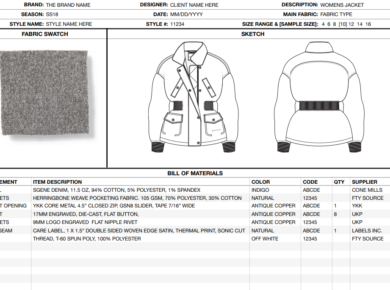Imagine you’re the conductor of a symphony. Only, instead of musicians, you’re orchestrating a complex network of designers, producers, transporters, and retailers. Welcome to your role as a sourcing professional in fashion supply chain management. But watch out! Just as a single out-of-tune instrument can disrupt a concert, any weak link in your supply chain can create havoc with your fashion line’s smooth operation.
“Fashion supply chain management is like conducting a symphony – keeping all parts in harmony is crucial.”
Do you want to master this symphony and mitigate risks that could harm your business value or your customers? This article explores the potential risks in fashion supply chain management and provides practical steps to mitigate them. It’s time to fine-tune your orchestra!
Risks in the Fashion Supply Chain and their Causes
Let’s delve into some of the most prevalent risks in the fashion supply chain and explore the root causes behind them. By understanding the ‘why’, we can better formulate strategies to combat these risks.
- Over-dependence on a single supplier: This risk rises when a fashion brand relies heavily on one supplier. The cause is usually rooted in the desire to simplify operations or reduce costs. However, this strategy can backfire if the supplier encounters issues, potentially disrupting the entire supply chain.
- Poor supplier performance: The cause of this risk is often a lack of due diligence when selecting suppliers. Without a thorough evaluation, a brand may end up with a supplier who fails to meet quality standards or deadlines, jeopardizing the brand’s reputation.
- Consumer demand unpredictability: Fashion trends can change rapidly and unexpectedly, making consumer demand highly volatile. This volatility presents a risk for brands that produce large quantities of a single style, only to find that consumer preferences have shifted.
- Quality Issues: This refers to the risk of producing items that do not meet the brand’s quality standards. It could result from poor workmanship, use of low-quality materials, or inadequate quality control mechanisms.
By acknowledging these risks and understanding their causes, fashion brands can take proactive steps to mitigate potential damage and safeguard their supply chains. Remember, a sturdy chain is about more than just strong links—it’s about anticipating and preparing for potential weak spots, too.

How can Fashion Brands Mitigate these Supply Chain Risks to Protect their Business
1. Mitigating Over-Dependence on a Single Supplier
Over-dependence on a single supplier can be a major risk in the fashion supply chain. This dependency can expose a brand to potential disruptions, financial instability of the supplier, and even quality issues. However, there are proactive steps that brands can take to mitigate this risk.
- Diversify Suppliers: Don’t put all your eggs in one basket. A brand should strive to work with multiple suppliers. This reduces the dependency on a single supplier and ensures continuity in case of any disruptions. A notable example is H&M which sources its materials from over 800 independent suppliers, spread across Asia and Europe, ensuring they are never tied down to a single supplier.
- Backup Plans: Brands should always have backup suppliers in place. This provides an alternative source to switch over in case of any issues with the primary supplier. Uniqlo, for example, maintains a network of multiple raw material suppliers to ensure uninterrupted production.
- Supplier Assessment: Regular assessment and evaluation of suppliers is crucial. This will help to monitor their financial stability, quality of goods and reliability. Companies like Zara conduct regular audits of their suppliers to ensure their standards are maintained.
- Strengthening Supplier Relationships: Building a strong relationship with suppliers can also help to mitigate risks. Open communication and transparency can help in early detection of any potential issues. For instance, Adidas maintains an open dialogue with all its suppliers, allowing early identification and resolution of any potential problems.
2. Mitigating Poor Supplier Performance
As we journey down the fashion supply chain, we inevitably encounter the critical role of suppliers. A weak link in this chain, such as poor supplier performance, can lead to a domino effect of problems. Let’s dive into how these issues can be mitigated to maintain a healthy, vibrant supply chain.
When it comes to fashion supply chains, the performance of your suppliers can make or break you. A stumble on their end can cascade down, disrupting your operations and damaging your brand’s reputation. So how do you protect yourself from this risk?
Diversification Is Key – The first step is to spread the risk. Just as with financial investments, putting all your eggs in one basket is a recipe for disaster.
- Diversification: Don’t rely on a single supplier. Partner with multiple suppliers to spread the risk out.
- Variety: Also consider diversifying the types of suppliers you work with. For instance, instead of only working with large manufacturers, consider partnering with smaller workshops.
Staying Prepared and Evaluating Regularly – Being proactive rather than reactive can save you a world of stress down the line.
- Contingency planning: Always have a backup plan. Know where you can turn if a supplier falls through.
- Regular evaluation: Continually assess your suppliers’ performance. This will allow you to spot any potential issues before they escalate.
| Strategy | Description |
|---|---|
| Diversification | Work with a variety of suppliers to spread out risk. |
| Preparedness | Have a contingency plan in place for potential issues. |
| Evaluation | Regularly check on your suppliers’ performance. |
Remember, the goal is to ensure a resilient supply chain. This means not just surviving disruptions, but bouncing back from them quickly and efficiently. By diversifying your supplier base, staying prepared for potential hiccups, and evaluating supplier performance on a regular basis, you can help safeguard your fashion brand from supply chain risks.
3. Mitigating Consumer Demand Unpredictability
Consumer demand can be as unpredictable as the latest fashion trends. A sudden shift in trends can leave retailers with large stockpiles of out-of-fashion items, leading to significant losses. However, there are feasible measures fashion brands can put in place to mitigate this risk.
- Demand Forecasting: By studying market trends, consumer buying behavior, and historical sales data, brands can make educated predictions about future demand. Demand forecasting is a powerful tool for adjusting production levels to match projected customer needs. For instance, the Spanish clothing brand Zara uses data analytics and trend forecasting to produce smaller batch sizes, allowing for quick adaptation to shifting trends.
- Agile Supply Chain: Having an agile supply chain can help brands respond swiftly to fluctuating consumer demand. An agile supply chain is flexible and can adjust production and distribution rapidly in response to changes in demand. A shining example is H&M, which operates with a short lead time, enabling rapid response to changing fashion trends.
- Diversified Product Range: Rather than betting on a single style, fashion brands can produce a diversified range of products. This strategy reduces the risk associated with unpredictability in consumer demand. A good example is the luxury brand Gucci, known for its eclectic product line that caters to a wide range of consumer tastes.
| Strategy | Example |
|---|---|
| Demand Forecasting | Zara |
| Agile Supply Chain | H&M |
| Diversified Product Range | Gucci |
4. Mitigating Quality Issues
- Invest in Quality Control: Implement a robust quality control mechanism. This could include regular inspections and audits at different stages of production. Top brands have stringent quality inspections at different stages of production to ensure the final product meets their high standards.
- Place Your Bets on Quality Control: Think about integrating a vigorous quality control system into your operations. Imagine periodic check-ups and audits sprinkled throughout your production process, just like the best in the business do. Your final product will not only meet your high standards, but will also exceed them. And don’t forget about certifying your factories regularly, ensuring they live up to those top-notch quality control standards.
- Choose the Right Supplier: Partner with manufacturers who have a reputation for producing high-quality items. These manufacturers should have a proven track record of delivering products that meet or exceed your brand’s quality standards.
- Train your Staff: Invest in regular training for your staff. Skilled workers are less likely to make errors and more likely to produce high-quality items. Consider staff visiting and experiencing other areas of the business. For example offshore sourcing teams get to visit HQ to understand different areas of the business and how the work they do leads to better practices elsewhere. This will encourage them to see the importance of their role and instilling high quality standards.
Remember, tackling quality issues head on is not only about maintaining a brand’s reputation but also about ensuring customer satisfaction and loyalty. By taking proactive steps to mitigate these risks, your brand can ensure that it delivers consistently high-quality products to the market.
In conclusion, the fashion industry is fraught with potential risks. From the threat of supply chain disruption to the impact of poor quality control, these issues can significantly affect a brand’s value and customer loyalty. However, by understanding these inherent risks, sourcing professionals can take proactive steps to mitigate them. Whether it’s fostering ethical supplier relationships, implementing stringent quality control measures, or employing data analytics in decision-making, these strategies can help maintain a brand’s reputation and ensure customer satisfaction.
But the road to risk mitigation doesn’t have to be a lonely one. Sourcing Playground’s sourcing intelligence platform stands as a beacon for those seeking to navigate these uncertain waters. Our AI driven platform offers a comprehensive solution for sourcing experts designed to implement risk mitigation strategies for your supply chain to ensure you stay ahead.






